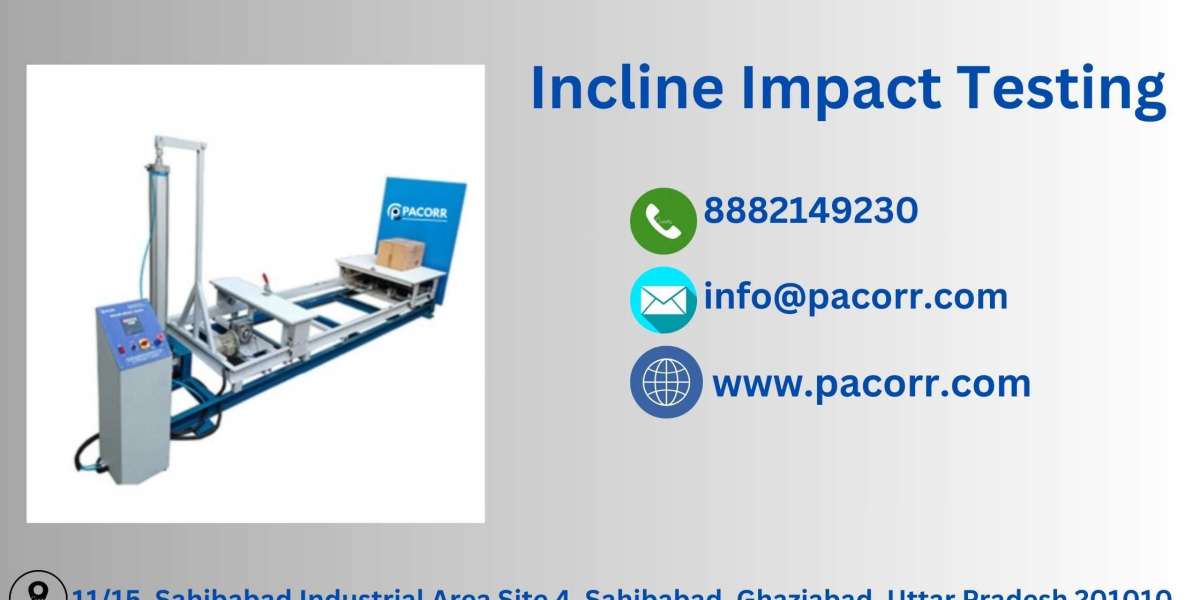INTRODUCTION
In the competitive landscape of product manufacturing, ensuring that products meet the highest standards of durability and safety is paramount. One of the critical aspects of product testing involves assessing the impact resistance of materials, especially when subjected to real-world scenarios like drops or collisions. This is where the Inclined Impact Tester comes into play—a sophisticated device designed to simulate and measure the impact forces on products and materials, providing manufacturers with essential data to improve and validate their product designs.
What is an Inclined Impact Tester?
The Inclined Impact Tester Price is a precision instrument used to evaluate the impact resistance of materials by simulating the effects of a sudden impact or collision. This testing method is particularly important for products that are likely to encounter such forces during transportation, handling, or usage. The tester is designed with an inclined plane, allowing the test specimen to slide down the plane and collide with a fixed object or barrier. The impact force is then measured to determine the material's resistance to damage.
Key Features of the Inclined Impact Tester
- Adjustable Inclination Angle: The tester allows for the adjustment of the inclination angle, providing flexibility to simulate different impact scenarios. This feature is crucial for replicating various real-world conditions that a product might face.
- High-Precision Sensors: Equipped with advanced sensors, the Inclined Impact Testing accurately measures the force of impact. This precision ensures reliable data, which is essential for manufacturers to assess the durability of their products.
- Durable Construction: Built with high-quality materials, the tester is designed to withstand repeated use over time. Its robust construction ensures consistent performance, making it a reliable tool for quality control.
- User-Friendly Interface: The device is equipped with an easy-to-use interface, allowing operators to set up and conduct tests with minimal training. This feature enhances productivity and reduces the potential for operator error.
- Versatile Application: The Inclined Impact Tester can be used to test a wide range of products and materials, including packaging materials, automotive parts, and consumer goods. This versatility makes it an invaluable tool for various industries.
Importance of Inclined Impact Testing
Inclined impact testing Price is a critical component of product quality assurance. It helps manufacturers identify potential weaknesses in their products that could lead to failure under impact conditions. By subjecting materials to controlled impact tests, manufacturers can gather data on how their products will behave in the real world. This information is vital for making informed decisions about material selection, design improvements, and product development.
Moreover, inclined impact testing is often required to meet industry standards and regulations. Many industries, such as automotive, aerospace, and packaging, have strict guidelines that products must adhere to before they can be brought to market. The Inclined Impact Tester ensures that manufacturers can meet these requirements and deliver safe, reliable products to consumers.
Applications of the Inclined Impact Tester
The Inclined Impact Tester is used across a variety of industries to ensure product durability and safety:
- Packaging Industry: In the packaging industry, it is crucial to ensure that containers and packaging materials can withstand the rigors of transportation and handling. The Inclined Impact Tester helps in evaluating the impact resistance of packaging materials, ensuring that they protect their contents effectively.
- Automotive Industry: Automotive components must endure significant forces during collisions or accidents. The Inclined Impact Tester is used to assess the impact resistance of various automotive parts, helping manufacturers improve vehicle safety.
- Consumer Goods: For products such as electronics, household appliances, and toys, impact resistance is essential to prevent damage during use. The Inclined Impact Tester provides valuable data to ensure these products are robust enough to withstand everyday wear and tear.
- Construction Materials: In the construction industry, materials like glass, tiles, and concrete are tested for their impact resistance to ensure they can withstand the forces they will encounter in real-world applications.
How to Conduct Inclined Impact Testing
Conducting a test with the Inclined Impact Tester involves several steps:
- Sample Preparation: The material or product to be tested is prepared according to specific guidelines. The sample should be representative of the actual product to ensure accurate results.
- Setting the Inclination Angle: The tester's inclination angle is adjusted to simulate the desired impact condition. This could range from a shallow angle for minor impacts to a steeper angle for more severe collisions.
- Test Execution: The sample is placed on the inclined plane, and the test is initiated. The sample slides down the plane and collides with the fixed object, simulating an impact.
- Data Collection: The tester's sensors measure the force of the impact, and the data is recorded. This data is then analyzed to determine the material's impact resistance.
- Result Analysis: The results are compared against industry standards or product specifications to assess whether the material meets the required criteria. If necessary, the product design or material selection may be adjusted based on the findings.
Conclusion
The Inclined Impact Tester Price is an indispensable tool for manufacturers seeking to ensure the durability and safety of their products. By simulating real-world impact conditions, this device provides critical data that can be used to improve product design, meet industry standards, and ultimately deliver high-quality products to the market. Whether in the packaging, automotive, consumer goods, or construction industry, the Inclined Impact Tester plays a vital role in product development and quality assurance.
For more information about the Inclined Impact Tester and other testing equipment, visit Pacorr Testing Instruments Pvt Ltd. Our range of state-of-the-art testing instruments is designed to meet the diverse needs of industries worldwide, ensuring that your products are tested for quality and durability with the utmost precision.
FAQ: Inclined Impact Tester
- What is the primary function of an Inclined Impact Tester?
The primary function of an Inclined Impact Tester is to simulate and measure the impact forces that materials or products experience during real-world scenarios like drops or collisions. This helps manufacturers assess the impact resistance and durability of their products.
- How does the Inclined Impact Tester work?
The Inclined Impact Teste works by sliding a test specimen down an inclined plane towards a fixed object or barrier. As the specimen collides with the object, the tester measures the force of the impact, providing data on the material's resistance to damage.
- What types of products can be tested using an Inclined Impact Tester?
The Inclined Impact Tester can be used to test a wide variety of products, including packaging materials, automotive components, consumer goods, construction materials, and more. It is versatile and applicable across multiple industries.
- Why is impact testing important for product development?
Impact testing is crucial for identifying potential weaknesses in products that could lead to failure when subjected to impact forces. It helps manufacturers improve product design, select appropriate materials, and ensure that their products meet industry standards and safety regulations.
- What industries commonly use Inclined Impact Testers?
Inclined Impact Testers are commonly used in industries such as packaging, automotive, consumer goods, construction, and aerospace. These industries require their products to be durable and capable of withstanding impacts during transportation, handling, or use.
- Can the Inclined Impact Tester simulate different impact conditions?
Yes, the Inclined Impact Tester allows for the adjustment of the inclination angle, enabling the simulation of various impact conditions. This flexibility helps manufacturers test their products under different scenarios, from minor impacts to severe collisions.
- What kind of data does the Inclined Impact Tester provide?
The Inclined Impact Tester provides data on the force of impact, which can be used to assess the impact resistance of the tested material. This data is essential for making informed decisions about product design and material selection.
- How do I prepare a sample for testing with the Inclined Impact Tester?
Sample preparation involves ensuring that the material or product to be tested is representative of the actual product. It should be prepared according to specific guidelines to ensure accurate and reliable test results.
- Is the Inclined Impact Tester easy to operate?
Yes, the Inclined Impact Tester Price is designed with a user-friendly interface, making it easy to set up and conduct tests with minimal training. This helps enhance productivity and reduce the potential for operator error.
- How does the Inclined Impact Tester contribute to quality control?
By providing precise data on the impact resistance of materials, the Inclined Impact Tester helps manufacturers ensure that their products meet quality standards and are capable of withstanding the stresses they will encounter in real-world applications. This is a critical aspect of quality control and product safety.
- Can the Inclined Impact Tester be used to meet industry standards?
Yes, many industries have specific standards and regulations that products must meet before they can be brought to market. The Inclined Impact Tester helps manufacturers ensure that their products comply with these requirements by providing accurate impact resistance data.
- What maintenance is required for the Inclined Impact Tester?
Regular maintenance of the Inclined Impact Tester involves checking the calibration of sensors, ensuring the mechanical parts are in good condition, and following the manufacturer's guidelines for upkeep. Proper maintenance is essential for ensuring the accuracy and longevity of the equipment.


